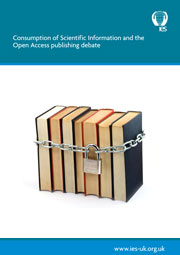The Issue: The UK Government has recently backed The Wellcome Trust – the largest non-governmental funder of medical research – in their decision to make all of the research that it funds widely available in the public domain. Open access publishing, where articles are made freely available as soon as they are published, provides an alternative model whose popularity over traditional subscription publishing is growing.
The publishing landscape: For over 350 years the communication of research findings, through the medium of scientific publishing, has been at the heart of scientific enterprise. Scientific publications have enabled researchers to use targeted research to achieve scientific progress through building on the work of others, contributing additional ideas and observations and developing new questions and theories. Currently there are three methods by which scientific information is accessed:
- Traditional Subscription publications
- Open access publications
- (Institutional) Repositories.
The Report: This report documents how frequently and by what medium environmental scientists access scientific information. It evaluates IES members’ opinions of open access publishing in order to establish whether this issue has made an impact on the membership as a whole. IES members are specialists and professionals that come from all areas of the environment sector, wherever jobs are underpinned by sound science.
Method: In order to establish opinions on open accessing publishing models IES members were encouraged to complete a survey that gathered responses in spring 2012.
Profile of participants: The largest profession represented by respondents was consultancy. The sector that was best represented in the results was air quality management (20% of respondents). 28% of respondents worked in academia or were currently still studying. This may impact the results of questions around access to and frequency of use of journals, as academics and students have greater access to journals and are therefore likely to use a greater number of journals more frequently than those in other sectors.
How and why environmental scientists access scientific information Key Finding: 50% of respondents access journals for personal or general interest suggesting that members read scientific literature outside of their employment field for interest. The primary ways that members accessed scientific information are through online journal material, seminars/conferences/lectures, websites and printed journals. Predominantly, members accessed scientific information for research (73%) and/or to keep up with current trends (71%).
Frequency of journal use Key Finding: The majority of members use journals on a regular basis. Most members had used between one and 10 journals in the last month (74% of respondents fall in these categories). When considering all respondents, most members access journals on at least a monthly basis. This frequency shifts when student members are excluded as fewer members fall into the ‘daily’ and ‘weekly’ frequency categories. Similarly, the number of journals accessed by respondents in the past month is lower when students are excluded. 75% of respondents use specialist journals, general scientific journals and professional body journals were the next most-accessed at 60% each. It can be assumed from these figures that most IES members are familiar with journals as portals for scientific information.
Journal access Key Finding: Members’ preferred method for accessing journal content is online: through general sources such as Google Scholar (65%) and through specific websites such as online research databases (58%); followed by print form (35%). Predominantly, it is the employers or universities who pay for members’ access to journal content (69%), although a significant proportion of members also personally pay for content (30%). Despite a small proportion of members accessing journal content in print form, a significant majority use online sources indicating that a shift to open access would not drastically change the way that members access content.
Journal subscriptions Key Finding: Financial considerations are cited as the primary cause of subscription lapses (59% of respondents) and also he reasons preventing other members from taking out subscriptions to journals in the first place (51% of respondents). The majority of members (51%) do not subscribe to any journals. Of those members that do subscribe, the largest proportion have subscribed to journals for six years or longer. Where members have allowed subscriptions to lapse, the primary reason given was cost (59%). Similarly, for those members who have never subscribed to journals, the primary reasons given were ‘financial costs’ (51%) and ‘Availability of material through work or university’ (58%).
Journal follow up Key Finding: While the majority of members are satisfied, 34% would appreciate the provision of online forums or comment boards to enable further discussion. The primary ways in which members follow up after accessing journal content are through further research or discussion with friends/colleagues. The majority of members (44%) are satisfied with the opportunities they have for discussing journal articles.
Open Access journals Key Finding: 49% of respondents consider the effect of restricting content on scientific progress to be ‘severe’ or ‘bad’. Most respondents were either unsure whether or not they had used an open access journal or did not think that they had. When asked why they considered open access journals to be different from traditional subscription journals, more respondents felt that open access journals were ‘better’ or ‘much better’ than felt they were ‘worse’ or ‘much worse’. The mixed messages in these results suggest that members are still unsure about the nature of open access publishing. For example, of the 39 ‘open access’ journals listed by name that members access, 14 were not open access publications. Given that most respondents had no opinion as to whether open access journals were the same, better or worse than traditional subscription journals it was surprising that the majority of respondents answered ‘yes’ when questioned on whether they would like more journals to be open access.This suggests that the theory of open access publishing is more attractive to environmental scientists than the reality of it.
Conclusion The report concludes that a lack of available information about open access publishing and open access journals is hindering uptake of this model among environmental scientists. Positive opinions about the theory of open access publishing does not seem to translate to motivation to be involved with open access publishing or increased likelihood of using these sources with ‘scientific quality and integrity’ of journal content being cited as a concern.


